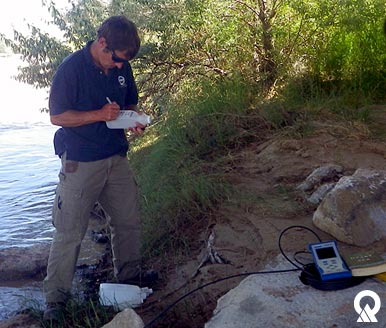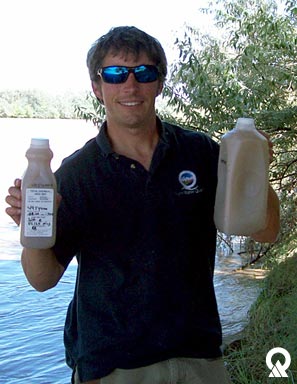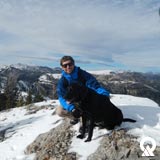By Christine Osborne
This week, we take a look back at DEQ’s response to the Gold King Mine release two years ago. On August 5, 2015, EPA contractors were clearing debris from the opening of the Gold King Mine near Silverton, Colorado, when the blockage gave way, releasing three million gallons of acid mine drainage into the Animas River.
Ben Brown, an environmental scientist in the Division of Water Quality (DWQ) Monitoring Section, was one of the first on the scene at the spill’s expected point of entry into Utah. He relates what happened next in this 2015 interview.
How was the decision made to sample the river after the spill?
It wasn’t a question of whether the plume would reach Utah, it was more a question of when. DWQ Spills Coordinator Doug Wong has already arrived at the San Juan River on Friday, August 7th, but we needed more water scientists onsite to begin sampling. I consulted with Erica Gaddis (who is now the Division Director of DWQ) about sampling locations late Friday night, prepped my truck and gear, went home, and headed to the river early Saturday morning.
How did you decide where to sample?
We needed consistent sampling locations to accurately assess the impact of the plume on the river. We looked for sites that we had sampled before so we would have some historical data. We also chose sites that were fairly accessible and located spatially along the path the plume would travel so we could capture any impacts from the plume over time. Three of the four sites had historical DWQ data, and the fourth site filled the gap between the other sites.
What were you looking for?

A couple of things. We needed sampling data before the plume arrived so we would have a baseline for comparison. The San Juan was really muddy from recent rains, so we probably weren’t going to be able to “see” the plume when it arrived. We tested the river’s pH since it would likely become more acidic once the plume arrived, and a change in pH at our sampling site at the state line could help us determine when the plume reached Utah. Mine drainage contains heavy metals, so we tested for total and dissolved metals and took sediment samples along with a few other general water chemistry tests. We did the chemical tests in the field, measured and recorded instantaneous field readings at the site, labeled the bottles, and kept them on ice for transport.
What were some of the challenges?
Well, when you go out into the field in an emergency situation, you don’t know how long you will be there or how much equipment to bring. I took down a lot of sampling bottles, a cooler and ice to keep the samples at a consistent temperature, a hydrolab probe for real-time readings, a flow measuring device, safety-grade chains, a calibration solution, a pump to pump water for filtering, chemical tests for field evaluations, waders, gloves. Even with all that preparation, we still ran out of bottles because we were down there longer than we expected. Fortunately, my coworkers were traveling back and forth from Salt Lake constantly, so we were able to get supplies when we ran out.

Because the sites were fairly remote and spread out, we spent a lot of our time driving down rough roads simply to get to the sites. We visited the four sites two times a day, took samples, took photos of the site each time we sampled, prepped and processed samples, and checked the hydrolab probe. We had a lot of 12-hour days.
Communication was a real problem, because we were often out of cell range and reception was spotty at best. We had storm events while we were there, and the resulting flooding washed sediment from tributaries into the San Juan, complicating our sampling efforts and sampling results. On the upside, the high flows probably helped dilute the metals in the plume.
How did you get the samples back so quickly?
A DWQ scientist drove down each day, stayed the night, and another member of our monitoring crew would get up the next morning and drive back to Salt Lake so the lab would have the samples by early afternoon. We repeated this process for over a week. The Department of Safety offered us the use of their plane to fly samples up to Salt Lake, and that was a huge help.
What was the experience like for you?
I love that area of the state, and I’ve floated the San Juan many times on my own time. In fact, one of the reasons I was sent down to sample was my familiarity with the area. It certainly gave me a different perspective of the river, which I’ve seen running blue and clear this time of year. The storms carried a lot of sediment into the river, so it wasn’t what I expected.
The experience was exciting in many ways, and it gave me an opportunity to use my knowledge and monitoring skills to respond to an emergency situation. The team at DWQ did a great job coordinating the sampling and the arrangements for sample pickup, so I felt like we had the support we needed to get the job done. Overall, it was unique and rewarding experience, and I was glad I was a part of it.
Visit DEQ’s Gold King Mine webpage for more information about the spill and its aftermath.

I have worked in the DWQ Monitoring Section for 12½ years as an Environmental Scientist. My primary role is to coordinate statewide field sampling programs. Some of the key field projects I facilitate include the Utah Comprehensive Assessment of Stream Ecosystems (UCASE), National Aquatic Resource Surveys (NARS), Ambient Water Quality Intensive surveys, and the Fish Tissue Contamination Program. I have a degree in environmental studies with an emphasis in watershed science and a minor in wildlife biology from the University of Montana. I was born and raised in Utah and currently live in Kamas where I have plenty of access to enjoy the outdoors. Most of my time away from work involves being outside where I enjoy backpacking, hiking, rafting, skiing, hunting, snowmobiling, ice-fishing, camping, gardening, and landscaping. I feel very fortunate to have a job that lets me travel the beautiful state of Utah and gives me an opportunity to work on a wide array of water-quality issues.

